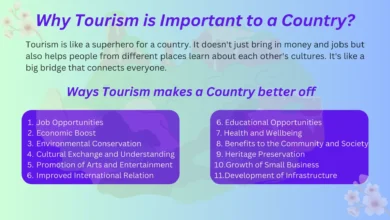
Sustainability in tourism product development
These days, there’s no denying that sustainability and the environment are hot topics in all industries especially in the tourism sector. Whether you’re looking to boost your business or to make more environmentally conscious decisions, it’s important to keep sustainability top of mind when creating or improving your product offerings. Here are just some of the ways sustainable tourism practices can benefit your company, along with some tips on how to implement them successfully in your product development process.
Sustainability makes a difference:
Sustainability isn’t a trend that can be ignored. In a world where people have become used to abundance, thinking about what we do with our time and money has begun to fall by the wayside. That being said, it’s important to remember that there are consequences for every action – even if they don’t seem so important at first glance.
Small changes like adding sustainable practices into your hotel or resort business can yield big results – not only environmentally but also financially. By implementing sustainable practices into your product offerings, you’ll see positive impacts on both guests and employees alike. It may sound clichéd, but doing good really does feel good! The good news is that sustainability doesn’t have to be difficult; as long as you know where to start, incorporating new eco-friendly products and processes into your offerings will be an easy way to create change. Here are some simple tips:
1) Identify hot spots:
The biggest challenge of maintaining a sustainable business model knows which areas need improvement most. Start by looking at your current operations and pinpointing any hot spots (areas that use more energy than others). You can easily identify these problem areas using software such as Hot Spotter, which allows you to quickly identify how much energy different parts of your property use. Once you know where your biggest problems lie, implement solutions immediately.
2) Choose eco-friendly products:
There are plenty of green alternatives out there for just about everything under the sun from light bulbs to cleaning supplies. Take some time to research greener options for all of your products and services.
3) Change habits:
Changing habits can be tough, especially when you’re already working hard to keep up with daily demands. But making small changes like turning off lights when you leave a room or turning down thermostats during off hours can add up over time and make a big difference in energy consumption.
Sustainability sounds good, but what does it mean?
Sustainability sounds like a great idea, but it’s not always easy to implement. There are different definitions of sustainability, and they all have varying levels of requirements for businesses and cities to follow. No matter how you define sustainable travel or business practices, there are aspects that you can integrate into your own travel planning. Here are some tips on getting started with sustainability:
1) Identify what makes your destination unique and make sure you experience these things first-hand;
2) Investigate transportation options before you arrive at your destination;
3) Make an effort to support local businesses and organizations;
4) Take time to get involved with community initiatives.
5) Respect local customs and culture by learning about them before you visit.
6) Participate in eco-tourism activities when possible (for example, visiting wildlife sanctuaries instead of national parks). If you keep these simple steps in mind while traveling, then sustainability will become second nature!
What are sustainable tourism products (STP)?
Tourism products are becoming increasingly important to sustainable tourism. For example, eco-lodges and camps offer an alternative to environmentally damaging forms of accommodation such as mass-market hotels. Eco-tourism has been defined as responsible travel to natural areas that conserves the environment and improves the well-being of local people.
A sustainable tourism initiative began with a focus on rural communities around twenty years ago but now includes all types of communities, geographical locations, and stakeholders. Sustainable tourism products can be found throughout Europe and also globally in countries like Costa Rica, Tanzania, Fiji, and Kenya. The concept of STP can be applied across different regions based on their socio-economic factors. Aspects of nature, culture, and community are vital to making sure that tourists receive a genuine experience from their visit.
It is important for destination managers to take into account how they want tourists to perceive their destination so they can design appropriate products which will not only enhance tourist experiences but also benefit local communities.
Is sustainable tourism profitable?
Sustainable tourism has been a major topic of discussion for several years. The question, however, remains whether or not sustainable practices can produce profitable results. Many companies claim to be doing green business and even encourage others to get involved in environmentally friendly initiatives. Despite these efforts, a company cannot call itself truly green if it is not making any money.
As a result, many people are still skeptical about just how important sustainability really is. In fact, some businesses have gone so far as to say that they are willing to sacrifice profits in order to remain true to their values and beliefs. Others have suggested that such an approach will ultimately prove unsuccessful. So what’s behind all of these claims? Are there actually ways for businesses to make money while also remaining sustainable? How do we measure success when we consider environmental factors like water conservation and carbon emissions?
But why should I bother with this if my competitors don’t do it?
Most businesses aren’t as aware of or concerned about sustainability as they should be. This doesn’t mean that all business leaders are amoral, but it does indicate that most businesses place a higher priority on profits than they do on other concerns, like environmental protection and corporate responsibility.
In order to stand out from your competitors, you need to be proactive about developing sustainable tourism products. By doing so, you can attract environmentally conscious customers while also reducing your overall carbon footprint. And if your competitors don’t follow suit, you might even end up with a competitive advantage over them!
How can I start implementing STP into my business strategy?
The sustainable tourism movement (STM) has become mainstream, with an increasing number of organizations implementing it as part of their strategy. However, many businesses still struggle to develop sustainable strategies and STP may seem complex or too expensive. But with a focus on integrating socially responsible factors into existing planning processes, any business can work towards making positive changes that improve social and environmental performance, reduce costs and enhance productivity.
Conclusion:
Tourism can play a vital role in supporting local people and creating economic opportunities. But it’s not just local people who benefit. As tourists, we should feel pride and ownership of the destinations that enrich our lives. A responsible industry leads to a more sustainable and successful tourist experience for all involved. As responsible tourists, we need to recognize how our behavior can affect small communities across countries and continents, making sure that every touristic interaction is positive for all parties involved.




